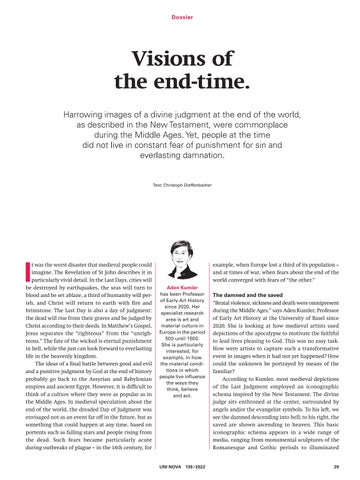Dossier
Visions of the end-time. Harrowing images of a divine judgment at the end of the world, as described in the New Testament, were commonplace during the Middle Ages. Yet, people at the time did not live in constant fear of punishment for sin and everlasting damnation.
Text: Christoph Dieffenbacher
I
t was the worst disaster that medieval people could imagine. The Revelation of St John describes it in particularly vivid detail. In the Last Days, cities will be destroyed by earthquakes, the seas will turn to blood and be set ablaze, a third of humanity will perish, and Christ will return to earth with fire and brimstone. The Last Day is also a day of judgment: the dead will rise from their graves and be judged by Christ according to their deeds. In Matthew’s Gospel, Jesus separates the “righteous” from the “unrighteous.” The fate of the wicked is eternal punishment in hell, while the just can look forward to everlasting life in the heavenly kingdom. The ideas of a final battle between good and evil and a punitive judgment by God at the end of history probably go back to the Assyrian and Babylonian empires and ancient Egypt. However, it is difficult to think of a culture where they were as popular as in the Middle Ages. In medieval speculation about the end of the world, the dreaded Day of Judgment was envisaged not as an event far off in the future, but as something that could happen at any time, based on portents such as falling stars and people rising from the dead. Such fears became particularly acute during outbreaks of plague – in the 14th century, for
example, when Europe lost a third of its population – and at times of war, when fears about the end of the world converged with fears of “the other.” Aden Kumler has been Professor of Early Art History since 2020. Her specialist research area is art and material culture in Europe in the period 500 until 1500. She is particularly interested, for example, in how the material conditions in which people live influence the ways they think, believe and act.
UNI NOVA
139 / 2022
The damned and the saved “Brutal violence, sickness and death were omnipresent during the Middle Ages,” says Aden Kumler, Professor of Early Art History at the University of Basel since 2020. She is looking at how medieval artists used depictions of the apocalypse to motivate the faithful to lead lives pleasing to God. This was no easy task. How were artists to capture such a transformative event in images when it had not yet happened? How could the unknown be portrayed by means of the familiar? According to Kumler, most medieval depictions of the Last Judgment employed an iconographic schema inspired by the New Testament. The divine judge sits enthroned at the center, surrounded by angels and/or the evangelist symbols. To his left, we see the damned descending into hell; to his right, the saved are shown ascending to heaven. This basic iconographic schema appears in a wide range of media, ranging from monumental sculptures of the Romanesque and Gothic periods to illuminated
29
















